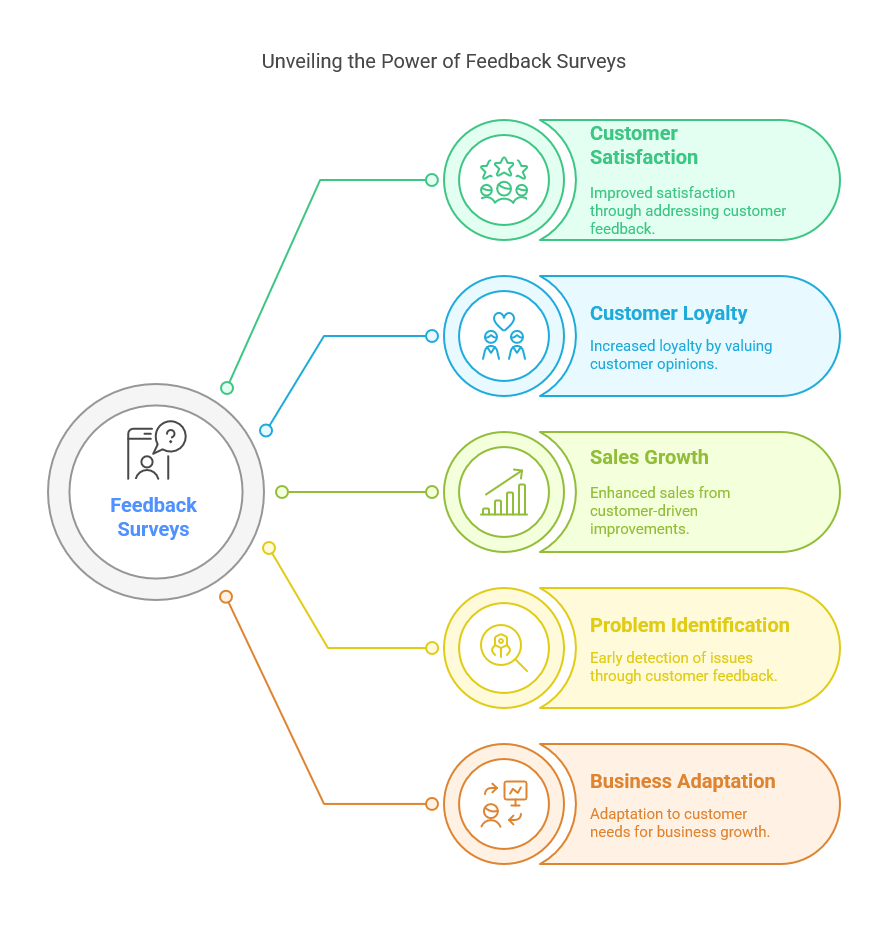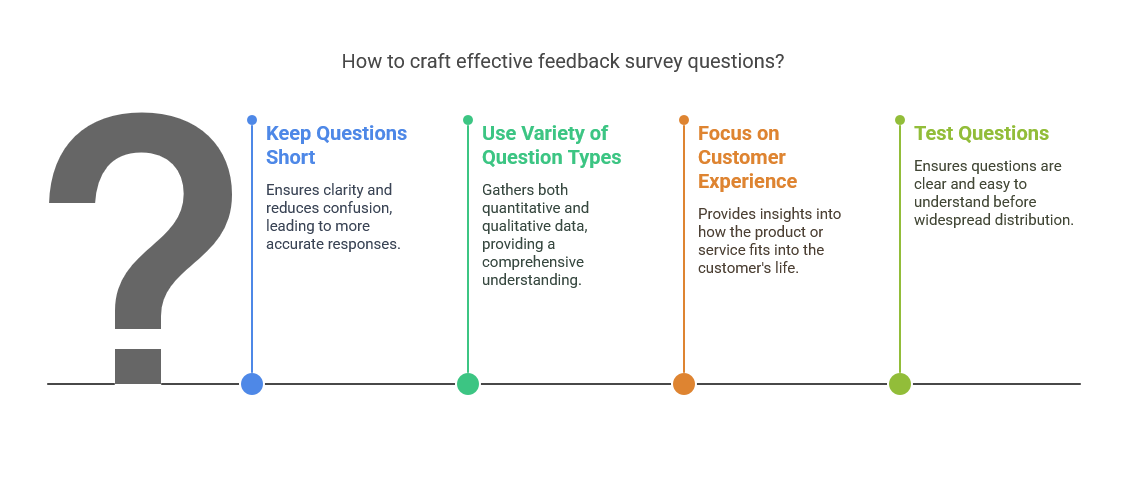Customer feedback surveys are essential tools for gaining insights into your business. They help you understand what works, what doesn’t, and what can be improved. The right feedback survey questions allow you to capture meaningful data that can drive growth and enhance customer satisfaction. In this blog post, we will cover the Top 10 Feedback Survey Questions you should be asking your customers to optimize their experience and increase business success.
Why Feedback Surveys Matter for Your Business
Feedback surveys serve as a direct line to your customers’ thoughts and opinions. With their help, you can gather valuable insights that enable your business to grow and adapt. Customer feedback surveys provide information on what your customers are happy about, what they dislike, and areas in which they feel improvements can be made.
Implementing feedback surveys has a clear impact on a business’s success. Studies show that businesses that listen to their customers and act upon their feedback see improved customer satisfaction, loyalty, and overall sales. In fact, according to a SurveyMonkey report, businesses that regularly gather customer feedback enjoy a 55% higher customer retention rate than those who don’t.
By asking the right feedback survey questions, you gain the data that will drive your business forward. These surveys help identify potential problems early on and allow you to make necessary adjustments before issues escalate. Here are the Top 10 Feedback Survey Questions to ask your customers:

Top 10 Feedback Survey Questions
1. How Satisfied Are You with Our Product/Service?
This is the most basic but essential question. A simple rating scale (e.g., 1 to 5 or 1 to 10) can give you an immediate understanding of how satisfied your customers are. It’s important to ask this question because it directly correlates with the customer’s overall experience. This helps identify trends in customer satisfaction that can guide improvements.
When customers are highly satisfied, they are more likely to return and recommend your product to others. On the other hand, if customers rate their satisfaction poorly, it’s crucial to dive deeper into the reason behind it, which brings us to the next question.
2. What Could We Do to Improve Your Experience?
This is one of the most valuable questions in a survey because it opens the door to actionable insights. By giving customers an opportunity to share what could make their experience better, you gather ideas that you might not have thought of. Customers may offer suggestions for new features, product improvements, or adjustments to your service.
Open-ended questions like this often lead to the discovery of innovative solutions that can give your business a competitive edge. It’s important to listen to this feedback and prioritize implementing changes based on customer needs.
3. How Easy Was It to Find What You Were Looking For?
For businesses that sell products online or offer services on their website, ease of navigation is a crucial factor in customer satisfaction. This question allows you to identify whether your website or product catalog is user-friendly. A complicated layout, slow load times, or a lack of clear product categories can frustrate customers and lead to lost sales.
By asking this question, you gain insights into the usability of your website or platform. If many customers struggle to find what they need, you can invest time and resources into improving the site’s layout and making it more intuitive for users.
4. Would You Recommend Our Product/Service to Others?
This question is based on the Net Promoter Score (NPS), one of the most effective methods to measure customer loyalty. The idea is simple: customers who answer positively to this question are more likely to be repeat buyers and will help grow your brand through word-of-mouth referrals.
If your customers say they would recommend your product or service, it indicates a strong relationship between your business and its audience. On the other hand, those who respond negatively may indicate underlying issues with your product or service that need immediate attention.
5. How Would You Rate Our Customer Service?
Customer service can make or break your business. You must ask your customers how they feel about the assistance they receive. A great customer service experience can turn a one-time buyer into a loyal customer. A poor experience, however, can drive customers away.
This question can help you gauge the effectiveness of your support team. You can ask about response time, helpfulness, and the professionalism of the customer service representatives. If many customers rate your customer service poorly, it’s time to reevaluate your processes and train your staff accordingly.
6. What Features or Services Would You Like Us to Add?
This is another open-ended question that helps you understand customer needs. If you already have a good understanding of what your customers expect from your product or service, asking them directly about new features or services they’d like to see can provide even more insights.
Often, customers know best what will improve their experience. They may suggest features you didn’t consider or even reveal problems that are common but not widely known. Use this feedback to guide your product development.
7. How Likely Are You to Use Our Product/Service Again?
Repeat customers are crucial to the long-term success of any business. This question lets you determine how likely customers are to return for additional purchases or services. If the answer is low, it might indicate that they didn’t see enough value in your product or that they’ve had a poor experience.
By understanding how many customers plan to return, you can assess whether your product or service is truly meeting their needs or if improvements are necessary to increase repeat business.
8. How Did You Hear About Us?
This is an essential question for tracking your marketing efforts. By asking customers how they found your business, you can determine which marketing channels are the most effective. Whether it’s word-of-mouth, social media, search engines, or paid advertisements, this feedback allows you to optimize your marketing strategy.
If one particular channel stands out, it might be worth investing more resources in that area. Conversely, if some channels are underperforming, you can reallocate your marketing budget to focus on more successful tactics.
9. Was the Product/Service Worth the Price?
This question directly relates to value for money. Sometimes customers feel they’ve paid more than what they received, while other times, they may find that your product or service is well worth the investment. By asking this question, you can gauge how well your pricing aligns with customer expectations.
If customers consistently feel that your product is overpriced, it might be worth reconsidering your pricing strategy or offering more value through improved features or additional services.
10. Would You Like to Share Anything Else?
The final question should allow customers to share any additional thoughts or feedback they haven’t had the chance to express. This could include suggestions, complaints, or even praise. While the other questions provide specific feedback, this open-ended question allows customers to share information that the rest of the survey may not have covered.
This is a great opportunity to uncover unexpected issues or new ideas that could be crucial for improving your business.
Tips for Crafting Effective Feedback Survey Questions
The way you craft your survey questions can have a big impact on the quality of the feedback you receive. Here are a few tips to keep in mind:
-
Keep it Short and Simple: Make sure the questions are straightforward. Long or complex questions can confuse customers and lead to inaccurate responses.
-
Use a Variety of Question Types: Mixing multiple-choice, rating scale, and open-ended questions ensures you gather both quantitative and qualitative data.
-
Focus on the Customer’s Experience: Keep the questions customer-centric. Rather than asking about the product in isolation, focus on how the product or service fits into the customer’s broader experience.
-
Test Your Questions: Before sending out your survey to a large audience, test it with a small group to ensure your questions are clear and easy to understand.

FAQ: Frequently Asked Questions About Feedback Surveys
1. How Often Should I Send Feedback Surveys?
You should send feedback surveys at key points in the customer journey, such as after a purchase, customer support interaction, or after a service delivery. Keep it to a few surveys per year to avoid overwhelming your customers.
2. What’s the Best Way to Distribute Feedback Surveys?
Email surveys are a common method, but you can also use pop-ups on your website or social media channels. Choose the distribution method based on where your audience is most active.
3. How Do I Analyze Survey Data?
You can analyze survey data using tools like Google Forms or SurveyMonkey. Look for common themes in open-ended responses and trends in rating-scale questions to guide improvements.
4. Should I Offer Incentives for Filling Out Surveys?
Offering incentives can help boost response rates, but make sure they are not too large, as they may skew the results. Small rewards, like discounts or a chance to win a gift card, are often effective.
5. How Can I Use Survey Feedback to Improve My Business?
Look for recurring issues or suggestions in the feedback. These insights can guide decisions about product development, customer service improvements, and marketing strategies.
Feedback surveys are vital tools that allow you to gather insights directly from your customers. By asking the Top 10 Feedback Survey Questions, you can better understand your customers’ needs and preferences, which will help you improve your products and services. Remember, it’s not just about collecting data—it’s about using that data to drive meaningful improvements in your business.

